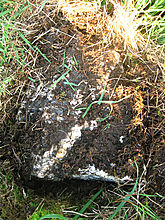|
|
|
|
PlezicaStone Circle
|
||||||||||||||||||||||||
|
|
|
Images (click to view fullsize) |
|







|
Fieldnotes |
|
|
OK. So when is a stone circle just a circle of stones? And when is a circle of stones a stone circle? Plezica throws up both questions. And not bad questions they are, as we're in west Wicklow, territory of the embanked stone circles of Boleycarrigeen and Castleruddery, and of the boulder circles at Athgreany and Broadleas (actually Kildare, but for geographic and situational purposes, lumped in here, along with Brewel Hill and Whiteleas circles too). Plezica (pronounced Plessica according to Liam Price, of whom more anon) stone circle, for that is what it's called on the National Monuments Records database, is not that well known. I found it on the NMR a couple of months back and have had an itch ever since. I've searched t'internet (not very thoroughly) and have found no mention of it anywhere. There is a Plezica House and a Plezica stoneworks and a few mentions of Plezica on some property websites, but no mention of a prehistoric stone circle, nor any other prehistoric monument of any kind. So Plezica has played on my mind and finally, on Good Friday last, I scratched. I'm not a great gardener but had spent a surprisingly enjoyable few hours in the afternoon having a go at the back garden before things got totally out of hand in the summer. Six o'clock in the evening is not the best time to head out into unknown territory, but the N81 corridor could have me down there in 20 minutes and the pull was just too much to resist. There's a chicane-like kink in the road at Crehelp, below Church mountain, about a mile south of Athgreany stone circle. Take the right turn here and travel for about another mile through the pleasant pastureland in the direction of Dunlavin. This minor road kinks in turn as it drops into a small valley – this is Plezica. There's a footpath marked on the OS map (sheet 55) and it's this path that I took (I had a much more detailed screenshot from archaeology.ie). So once more over a field gate into the unknown. Down the track/path, the site is at first hidden behind the crest of a hill to your right, then comes into view after about a minute. The field is a large one of open pasture and today the cattle are behind an electric fence to the west. The circle is overgrown and pretty nondescript at first glance. Curiously, it's fenced in with barbed wire and has its own farm gate. The fencing is right up on the raised platform that holds the circle, seeming to have been constructed to contain the stones inside it more than to keep anybody/thing out. Two trees have fallen within the enclosure and cover the stones in the east and north-east quadrant. None of the stones save the centre stone is taller than a metre. I counted, like Kelleher below, 18 in all, but not as evenly spaced as he describes. Two are of quartz, though one of these is quite small and lies flat and loose on the ground. The granite stones remind me of the boulders of Broadleas, or some of the stones outside the ring at Castleruddery. None of them appear to be embedded in the turf and there's little evidence of packing, again a reminder of Broadleas. The circle is most definitely on a raised and level platform, though substantial ploughing of the surrounds may make this seem more pronounced. The centre stone is curious; not on its own there – I saw a slab of slate-like stone beside it that is lying almost flat and is embedded into the turf. New growth and little time hindered any further exploration. The site is beautifully placed, almost at the head of a valley that slopes south towards Keadeen and Brusselstown. Indeed, from above to the north, there are no other features of substance, though east is the ridgeback of Church mountain, less impressive here than at Whiteleas. So what is it? A circle of stones yes; but a stone circle? Maybe. Price, who travelled widely in the county, doesn't mention it. Neither does Burl. Much of Price's work guided the later mapping and inventorying of the area, and yet nothing. There was much cairn-like material scattered throughout the floor inside the circle. That, and its small size and the fact that none of the stones seem embedded, could lead one to think 'denuded tumulus of some sort', the centre stones part of some chamber or cist, the circle itself kerbing. And yet, much of it reminds one of its neighbours, maybe a small derivative of these grander rings. Plezica may not be all that it promised to be, but it's still got enough to keep this megalithic adventurer/explorer happy, further deepening the mystery of the sites along the N81 corridor between Blessington and Baltinglass. There's much more to see out there! |
 Posted by ryaner
Posted by ryaner21st April 2014ce Edited 21st April 2014ce |
Miscellaneous |
|
|
Description from archaeology.ie: Description: On a slight crest in a broad valley of gently undulating terrain. A circular area (diam. c. 10.4m) enclosed by eighteen stones with a large granite boulder at centre (H 0.8m; 1.1m x 0.8m). The mainly granite stones are quite evenly spaced (c. 50cm apart) and are of a broadly similar size (H c. 0.35m; 0.65m x 0.55m). The largest stone (H 0.4m; 0.95m x 0.8m) is at S. A bank has possibly been incorporated into the perimeter of the circle at SE. Compiled by: Matt Kelleher Date of upload: 10 January 2013 Date of last visit: Thursday, April 22, 1999 |
 Posted by ryaner
Posted by ryaner19th April 2014ce |

